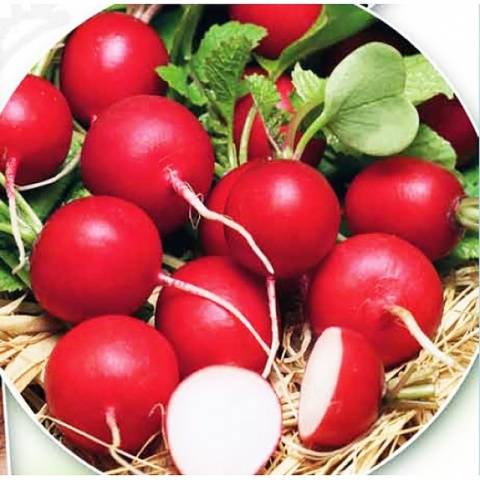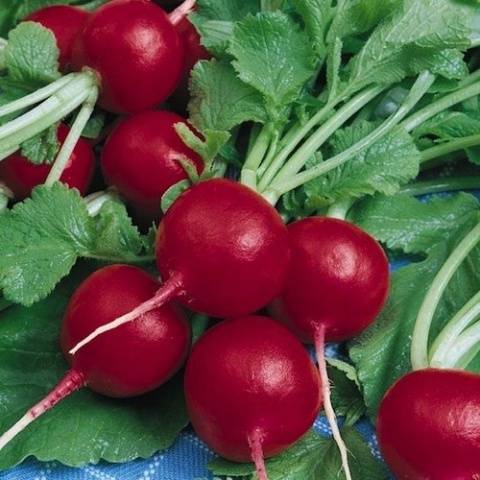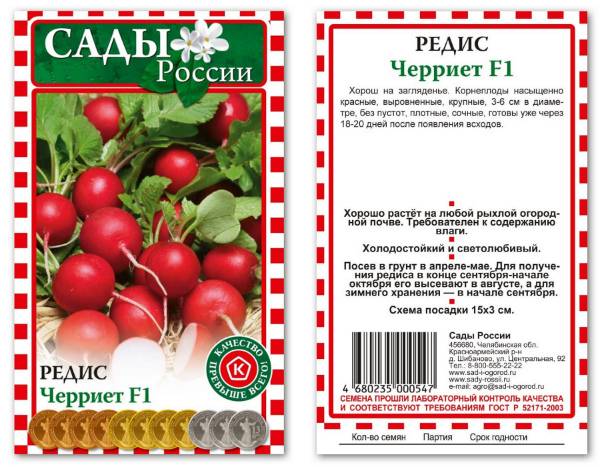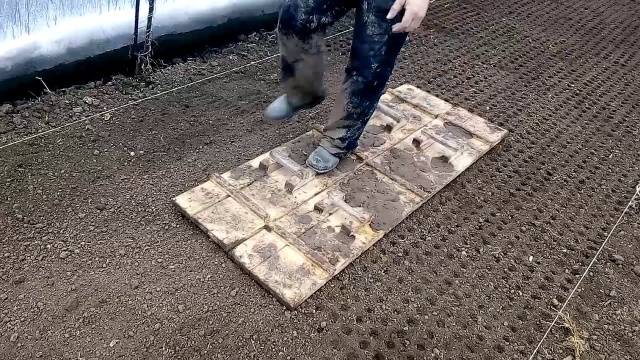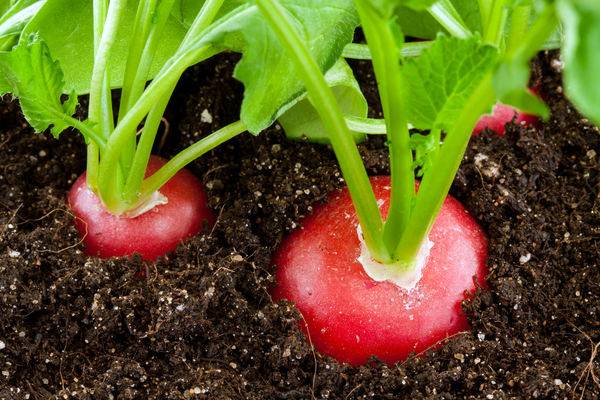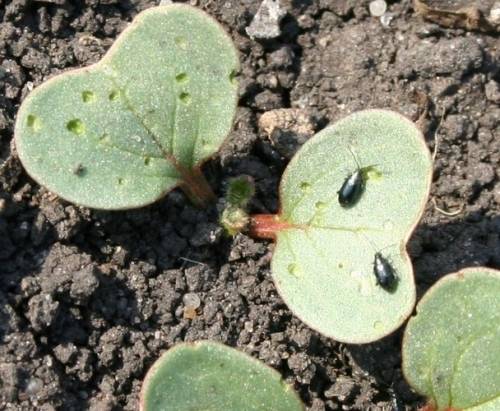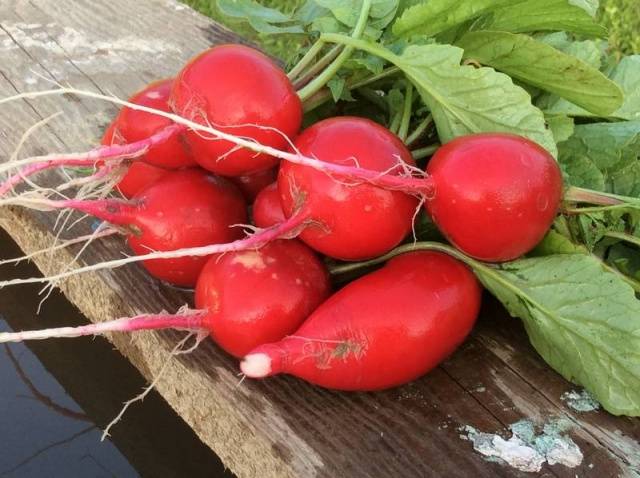Content
Radish is loved by many for being one of the earliest sources of vitamins on the spring menu. True, in recent years, many varieties and hybrids have appeared that are quite easy to grow in greenhouses, even in autumn and winter. And due to its resistance to shooting, such a radish can be safely grown in the summer heat. One of these hybrids is the Cherriet F1 radish.
Description
Cherriet radish hybrid was obtained by breeders of the Japanese company Sakata Seeds Corporation in the early 2000s. The originator and applicant for the registration of the hybrid in Russia was the subsidiary Sakata Vegetables Europe S.A.S., located in France. In 2007, Cherriet radish was already registered in the State Register of Russia and allowed for cultivation throughout the territory of our country.
Since this hybrid, unlike most radish varieties, is not particularly sensitive to the length of daylight hours, it can be grown both outdoors and in greenhouses during the spring and autumn periods.
For some reason, many sources, including the description of the variety from the "Gavrish" company, emphasize the early maturity of the Cherriet radish. But judging by the characteristics of the variety in the State Register, as well as reviews of gardeners, Cherryet radish belongs to medium-late varieties, that is, it fully ripens about 30 days after germination.
The rosette of leaves is rather compact, growing partly upward and slightly to the sides. The leaves are gray-green in color, obovate, narrowed at the base.
The root crop of Cherriet radish itself has a rounded shape with a convex head, the color is traditional, red.
The pulp is white, juicy, tender, not at all prone to flabbiness even in unfavorable growth conditions.
The taste and commercial qualities of this hybrid are assessed by experts as excellent, the pungency is moderate in moderation.
Cherryet radish is well transported and can be stored for quite a long time - up to a month in a refrigerator.
Cherryet is able to grow to good size, on average, the weight of one root crop is 25-30 grams, but radishes measuring 5-6 cm in size and weighing up to 40 grams are not uncommon. At the same time, large root crops, even with obvious overgrowth, never have voids in the pulp - they are always juicy and fresh.
The Cherryet hybrid is famous for its yield, which averages 2.5-2.7 kg / sq. m.
Cherryet radish is also highly resistant to various diseases: fusarium, black leg, keel.
Advantages and disadvantages
Cherriet radish has many advantages over other varieties.
Benefits | disadvantages |
Large size of root crops | Demanding on sunlight |
Not prone to peduncle formation | Not the earliest ripening dates |
Lack of pronounced sensitivity to the duration of daylight hours |
|
There are no voids in the fruit even when outgrowing |
|
Compact leaf outlet |
|
High yield |
|
Disease resistance |
|
Seed preparation for sowing
Sakata's seeds have already been treated with a special growth stimulant and are completely ready for planting, so no additional processing is required. The only thing that can be done with a large spread in seed sizes is to calibrate them in size: up to 2 mm inclusive, 2-3 mm and more than 3 mm.Each group of seeds should be planted separately, in this case the seedlings will be more friendly and the quality of the harvest will improve.
Growing features
The main feature of the Cherriet F1 radish is that, even in hot weather and long daylight hours in summer, it does not tend to form flower arrows like many of the radish varieties. Instead, the underground part is actively poured on the plants, for the sake of which this culture is actually grown.
For this reason, the cultivation period for Cherriet radish is not limited to the spring or autumn season. It can be sown and harvested richly throughout even the hottest summer.
In the open field
Usually, radish seeds are sown in open ground in most regions of Russia, starting in the first decade of April. Of course, in the southern regions, the timing may shift to early March, depending on the weather in the spring. If you want to constantly have fresh radishes on the table, the Cherriet hybrid can be sown during the warm season every two to three weeks until mid-September.
Being a cold-resistant crop, radish can withstand small frosts, down to -3 ° С (for seedlings) and up to -6 ° С (for adult plants), but it grows best at temperatures of + 12 ° + 16 ° С. For a more friendly germination in early spring, planting this vegetable is usually covered with a film on arcs or medium thickness non-woven material.
At an optimal temperature of + 15 ° + 18 ° C, seeds can germinate quite quickly - in 4-6 days. If it is still cold outside and the temperature sometimes drops to zero, then seed germination can take up to two weeks.
The best precursors for radishes are cucumbers and tomatoes. But it is impossible to sow it in the beds where any representatives of the cabbage family (turnip, radish, rutabaga, turnip, cabbage) grew before.
Many people use a two-row planting, with a gap between rows of 6-7 cm, and between rows 10-15 cm.Others prefer to sow in rows across the beds, while leaving a distance of 8-10 cm between the ribbons.
The optimum planting depth for radish seeds is 1-1.5 cm. With deeper sowing, the seedlings may be uncooked and uneven. It is advisable to cover the seeds with specially prepared fertile soil or humus.
The main thing in caring for radishes is watering. Watering is necessary regularly and abundantly, so that the ground at a depth of 10 cm is always moist. It is because of fluctuations in moisture in the soil that root crops can crack.
Top dressing is usually not required for radishes, especially if the bed was well fertilized for previous vegetable crops, since this vegetable is very early ripening and has time to take everything it needs from the ground.
In the greenhouse
In greenhouse conditions, cherry radish can be sown from March (and in the southern regions from February) to late autumn (October-November). If you have a heated greenhouse, you can try to grow this hybrid in winter, but it should be borne in mind that with a lack of light, the growing season increases and the radish may ripen twice as slowly.
When growing radishes in a greenhouse, it is especially important not to thicken the plants when sowing. Due to the compactness of the rosette of leaves, Cherryet radish can be sown according to the 6x6 cm scheme. When seedlings appear, it is advisable to reduce the temperature to + 5 ° + 10 ° C. Watering during this period should be moderate. With the beginning of the formation of root crops, the temperature is raised to + 16 ° + 18 ° С in sunny weather and up to + 12 ° + 14 ° С in cloudy weather. Watering is also increased, trying to prevent the soil from drying out.
Growing problems
Problems of growing cherry radish | Causes |
Shooting | Practically does not happen with Cherriet radish. Rarely, but it happens due to too high temperatures in summer |
The root crop is small or hardly develops | Lack of light or thickened fit. The seeds are buried too deep in the ground. Excess or lack of watering. Unstructured barren or freshly watered lands. |
Unpalatable root vegetables | Excess nitrogen fertilizers |
Fruit cracking | Sharp fluctuations in soil moisture |
Diseases and pests
Disease / pest | Signs of damage to radishes | Prevention / Treatment Methods |
Cruciferous fleas | They gnaw through leaves during germination and can destroy the entire plant | Completely close the radish plantings with thin agrofibre for 2 weeks before the formation of root crops, when the pest is no longer scary. Pollination of radishes every 2-3 days with tobacco dust, wood ash or a mixture of both. Spraying with infusions of tomato leaves, celandine, tobacco, dandelion |
Keela | Blisters form on the roots, the plant withers and dies | Do not plant radishes after growing cabbage vegetables |
Downy mildew | The formation of white plaque on the leaves leads to the death of the plant. | Strictly observe the distance between plants when sowing, spray with phytosporin |
Conclusion
Choosing a cherry radish will allow you to grow a delicious and juicy vegetable almost any time of the year without any problems.
Testimonials
